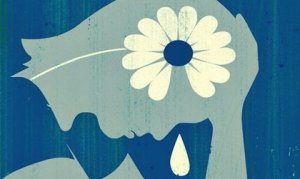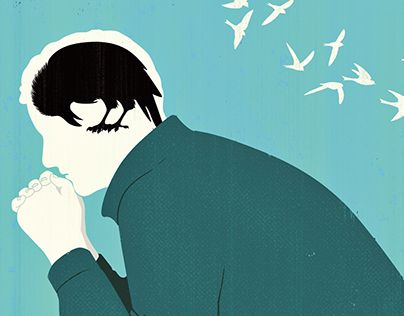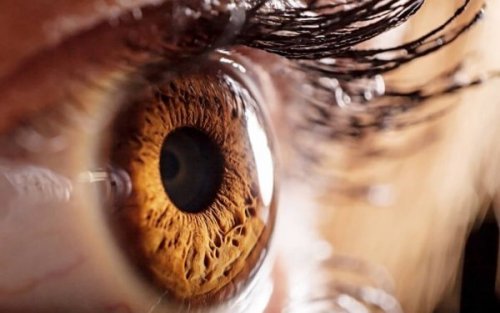Physical Symptoms of Depression: What Your Body is Telling You


Written and verified by the psychologist Valeria Sabater
The physical symptoms of depression are the brain’s ways to tell us that something isn’t okay. This complex disorder doesn’t only alter mood and thoughts. If there’s something characteristic about depression is how it impacts the body. It brings with it pain, fatigue, inflammation, and sleep problems, among others. Few conditions alter the body as intensely as this one.
Mental pain exists and is truly responsible for many physical illnesses. However, it’s easier for us to complain about back pain, headaches, and stomachaches than to say something dramatic like “life hurts”. If there’s something us humans know is that our reality can sometimes be complicated and painful.
Failures, losses, disappointments, and not knowing what to do or how to react to something brings suffering. It’s actually common for us to experience deep, emotional anguish without knowing why. We simply don’t know how to explain it and can’t think of a specific trigger. As you can see, depression has many different facets.
One thing that’s very common is experiencing an exhausting combination of anxiety and depression. Patients who experience this usually define this state as being scared and extremely tired at the same time. They want to be alone but they fear loneliness. They want to escape but can’t because they feel paralyzed.
Living with depression or any other disorder isn’t easy for anyone. However, studying the anatomy of these conditions is necessary to better understand what we’re facing.

Physical symptoms of depression: A body in pain
Depression hurts. We could define it in many ways: a paralyzing state, negative and even harmful thoughts, anguish, fear, sadness, apathy, and discouragement. However, it’s not common for people to openly express that depression is, above all, a reoccurring feeling of pain that can be physical as well as emotional.
The Dell Medical School of the University of Texas carried out a study in 2004. The results of this study supported what we stated above: physical symptoms are common in depression and, in fact, all of this symptomatology is evidenced by pain or an organic alteration.
Dr. Madhukar H. Trivedi was responsible for this study. He revealed that many patients go to their primary care centers due to their headaches, digestive problems, or back pain without knowing that they’re all physical symptoms of depression.
Tiredness, a feeling of heaviness, and general pain
Everything’s heavy, everything hurts, the body becomes sluggish, and patients feel like they’re living inside an oppressive diving suit. Most people with a depressive disorder experience these things.
Dr. Steven Targum, director of the Massachusetts General Hospital, explained in that study that depressed people can’t even benefit from a good night’s sleep. Even if they sleep for more than 12 hours, they still feel exhausted.
Back pain
If we had to mention a classic pain associated with depression, it’d definitely be back pain. If you’re wondering about the relationship between back pain and depression, we’ll refer to a study that Emory University carried out in the year 2016. These were the conclusions:
- There’s a link between the inflammatory pathways and the neurocircuits of the brain when it experiences alarm, fear, and anguish.
- There’s a reaction, a weakening of the immune system, and an inflammatory response that’s located mainly in the spine, in the nerves, and vertebrae.
Higher sensitivity to pain
Another one of the physical symptoms of depression is related to our pain threshold. All of a sudden everything becomes painful: a touch, a slight blow, changes in temperature, and different types of clothes, among others. Our skin and receptors become much more sensitive and, therefore, suffer more.

Digestive problems
People with a depressive disorder frequently suffer from all kinds of digestive disorders:
- Cramps.
- Slow digestion.
- Irritable bowel syndrome.
- Stomachaches.
- Constant feeling of fullness.
As a study from Harvard University pointed out, it’s important to always bear in mind the existent relationship between our brain and our digestive system. Factors such as stress, anxiety, fear, anguish, and sadness provoke a series of alterations that go from the esophagus all the way down to the colon.
Eye problems
This is quite a curious fact. Patients may suffer from a small eyesight dysfunction where they have trouble focusing on certain objects. Also, a lot of these objects may seem blurry. In addition, they experience a slight difficulty in differentiating white from black.
Studies like the one carried out at Harvard University indicate that, when someone is depressed, their world becomes more monochromatic and the colors grey and blue start to abound. This is a very striking fact.

As you can see, there are many physical symptoms of depression. However, it’s important to remember that all of these discomforts must go hand-in-hand with a series of emotional and cognitive alterations to be able to shape the clinical picture of depression.
The way to treat the depression will be decided by the mental health professional. Also, it’s essential to keep in mind that all types of depression are treatable. The moment the person experiences an improvement, most of these physical symptoms will disappear. When the mind is at peace, the body stops letting out warning signs. This leads to emotional well-being.
The physical symptoms of depression are the brain’s ways to tell us that something isn’t okay. This complex disorder doesn’t only alter mood and thoughts. If there’s something characteristic about depression is how it impacts the body. It brings with it pain, fatigue, inflammation, and sleep problems, among others. Few conditions alter the body as intensely as this one.
Mental pain exists and is truly responsible for many physical illnesses. However, it’s easier for us to complain about back pain, headaches, and stomachaches than to say something dramatic like “life hurts”. If there’s something us humans know is that our reality can sometimes be complicated and painful.
Failures, losses, disappointments, and not knowing what to do or how to react to something brings suffering. It’s actually common for us to experience deep, emotional anguish without knowing why. We simply don’t know how to explain it and can’t think of a specific trigger. As you can see, depression has many different facets.
One thing that’s very common is experiencing an exhausting combination of anxiety and depression. Patients who experience this usually define this state as being scared and extremely tired at the same time. They want to be alone but they fear loneliness. They want to escape but can’t because they feel paralyzed.
Living with depression or any other disorder isn’t easy for anyone. However, studying the anatomy of these conditions is necessary to better understand what we’re facing.

Physical symptoms of depression: A body in pain
Depression hurts. We could define it in many ways: a paralyzing state, negative and even harmful thoughts, anguish, fear, sadness, apathy, and discouragement. However, it’s not common for people to openly express that depression is, above all, a reoccurring feeling of pain that can be physical as well as emotional.
The Dell Medical School of the University of Texas carried out a study in 2004. The results of this study supported what we stated above: physical symptoms are common in depression and, in fact, all of this symptomatology is evidenced by pain or an organic alteration.
Dr. Madhukar H. Trivedi was responsible for this study. He revealed that many patients go to their primary care centers due to their headaches, digestive problems, or back pain without knowing that they’re all physical symptoms of depression.
Tiredness, a feeling of heaviness, and general pain
Everything’s heavy, everything hurts, the body becomes sluggish, and patients feel like they’re living inside an oppressive diving suit. Most people with a depressive disorder experience these things.
Dr. Steven Targum, director of the Massachusetts General Hospital, explained in that study that depressed people can’t even benefit from a good night’s sleep. Even if they sleep for more than 12 hours, they still feel exhausted.
Back pain
If we had to mention a classic pain associated with depression, it’d definitely be back pain. If you’re wondering about the relationship between back pain and depression, we’ll refer to a study that Emory University carried out in the year 2016. These were the conclusions:
- There’s a link between the inflammatory pathways and the neurocircuits of the brain when it experiences alarm, fear, and anguish.
- There’s a reaction, a weakening of the immune system, and an inflammatory response that’s located mainly in the spine, in the nerves, and vertebrae.
Higher sensitivity to pain
Another one of the physical symptoms of depression is related to our pain threshold. All of a sudden everything becomes painful: a touch, a slight blow, changes in temperature, and different types of clothes, among others. Our skin and receptors become much more sensitive and, therefore, suffer more.

Digestive problems
People with a depressive disorder frequently suffer from all kinds of digestive disorders:
- Cramps.
- Slow digestion.
- Irritable bowel syndrome.
- Stomachaches.
- Constant feeling of fullness.
As a study from Harvard University pointed out, it’s important to always bear in mind the existent relationship between our brain and our digestive system. Factors such as stress, anxiety, fear, anguish, and sadness provoke a series of alterations that go from the esophagus all the way down to the colon.
Eye problems
This is quite a curious fact. Patients may suffer from a small eyesight dysfunction where they have trouble focusing on certain objects. Also, a lot of these objects may seem blurry. In addition, they experience a slight difficulty in differentiating white from black.
Studies like the one carried out at Harvard University indicate that, when someone is depressed, their world becomes more monochromatic and the colors grey and blue start to abound. This is a very striking fact.

As you can see, there are many physical symptoms of depression. However, it’s important to remember that all of these discomforts must go hand-in-hand with a series of emotional and cognitive alterations to be able to shape the clinical picture of depression.
The way to treat the depression will be decided by the mental health professional. Also, it’s essential to keep in mind that all types of depression are treatable. The moment the person experiences an improvement, most of these physical symptoms will disappear. When the mind is at peace, the body stops letting out warning signs. This leads to emotional well-being.
All cited sources were thoroughly reviewed by our team to ensure their quality, reliability, currency, and validity. The bibliography of this article was considered reliable and of academic or scientific accuracy.
- Currie, S. R., & Wang, J. L. (2004). Chronic back pain and major depression in the general Canadian population. Pain. https://doi.org/10.1016/j.pain.2003.09.015
- Blume, J., Douglas, S. D., & Evans, D. L. (2011). Immune suppression and immune activation in depression. Brain, Behavior, and Immunity. https://doi.org/10.1016/j.bbi.2010.10.008
This text is provided for informational purposes only and does not replace consultation with a professional. If in doubt, consult your specialist.







